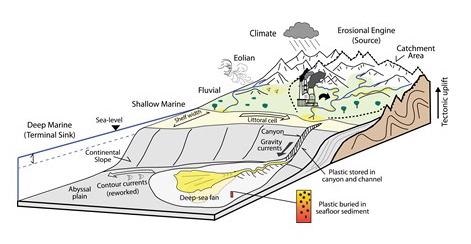May 4 2021
A new focus article published in the latest issue of the Geology journal outlines the study on plastic waste in sedimentary and marine surroundings.
 Pollutants, including plastic, reach deep-sea fans through linked sediment routing systems, as well as from outside the associated catchment(s), via near-shore and shelfal currents (that is, littoral cells), eolian transport, surface currents, and direct input from oceanic sources such as shipping and fishing. Image Credit: Modified from Hessler and Fildani (2019).
Pollutants, including plastic, reach deep-sea fans through linked sediment routing systems, as well as from outside the associated catchment(s), via near-shore and shelfal currents (that is, littoral cells), eolian transport, surface currents, and direct input from oceanic sources such as shipping and fishing. Image Credit: Modified from Hessler and Fildani (2019).
Environmental pollution caused by uncontrolled human activity is occurring on a vast and unprecedented scale around the globe. Of the diverse forms of anthropogenic pollution, the release of plastic into nature, and particularly the oceans, is one of the most recent and visible effects.
I.A. Kane, University of Manchester; A. Fildani, Deep Time Institute
Various studies were cited by the authors, which included one from the May issue penned by Guangfa Zhong and Xiaotong Peng, reviewed in an earlier GSA press release when it was published online ahead of print on January 26th, 2021. Zhong and Peng were astonished to determine plastic waste in a deep-sea submarine canyon that is situated in the northwestern South China Sea.
Plastic is generally considered to be the dominant component of marine litter, due to its durability and the large volume produced. Nano- and microplastics are a particularly insidious form of anthropogenic pollutant: tiny fragments and fibers may be invisible to the naked eye, but they are ingested with the food and water we consume and absorbed into the flesh of organisms.
I.A. Kane, University of Manchester; A. Fildani, Deep Time Institute
One of the crucial questions from the authors is, “If some plastics can survive for >1000 years in terrestrial environments, how long do they last in ocean trenches that are kilometers deep, dark, cold, and at high pressure? How long does it take microplastic to break down into microplastics and nanoplastics in the deep sea?”
While it is incumbent on policy makers to take action now to protect the oceans from further harm, we recognize the roles that geoscientists can play.
I.A. Kane, University of Manchester; A. Fildani, Deep Time Institute
This involves leveraging their deep-time point of view to meet the societal difficulties, their knowledge of the present-day distribution on the seafloor and also in the sedimentary record, by making use of the geosciences methods to record the downstream impacts of mitigation efforts, and to forecast the destination of seafloor plastics.
To summarize, the authors wrote, “We understand the transient nature of the stratigraphic record and its surprising preservation, and the unique geochemical environments found in deep-sea sediments.”
“Our source-to-sink approach to elucidate land-to-sea linkages can identify the sources and pathways that plastics take while traversing natural habitats and identify the context in which they are ultimately sequestered, and the ecosystems they affect. This will happen by working closely with oceanographers, biologists, chemists, and others tackling the global pollution problem,” added Kane and Fildani.
Journal Reference:
Kane, I A & Fildani, A (2021) Anthropogenic pollution in deep-marine sedimentary systems—A geological perspective on the plastic problem. Geology. doi.org/10.1130/focus052021.1.